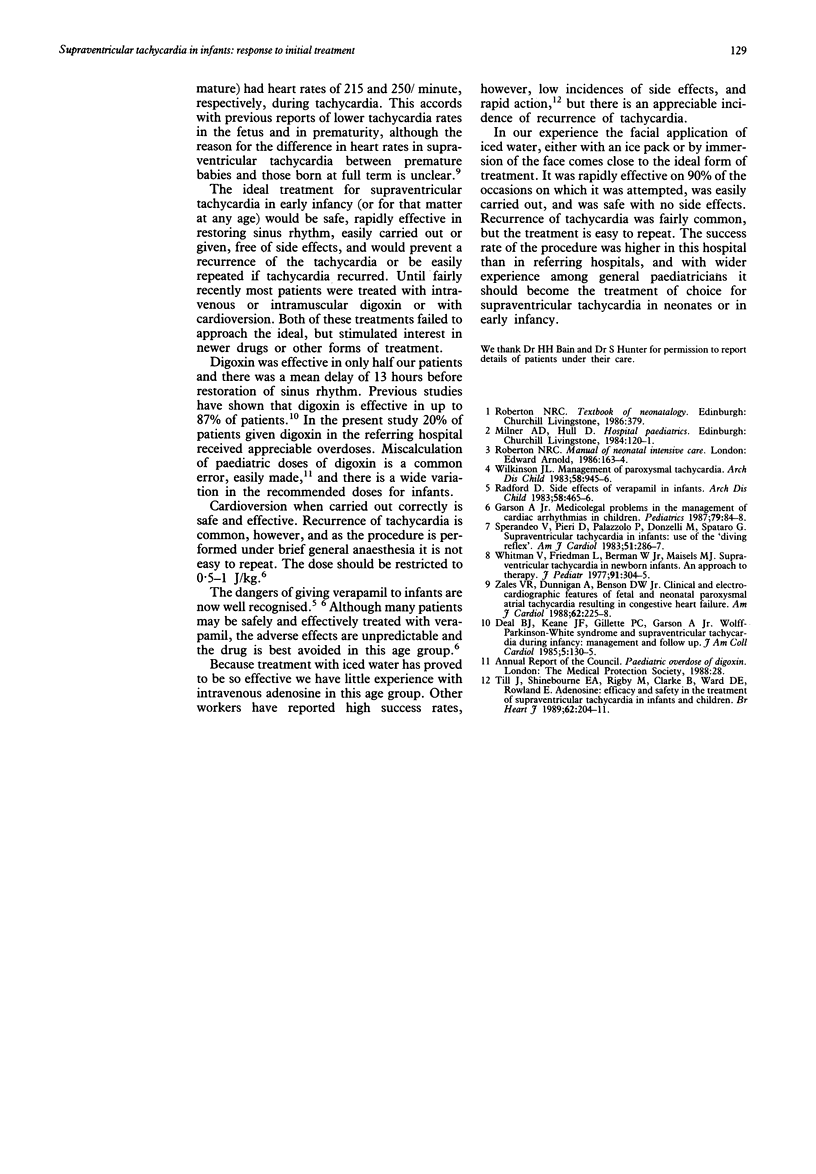Abstract
All patients with supraventricular tachycardia during the first 12 months of life who presented between 1977 and 1988 were identified by a retrospective survey of records in this hospital and by a questionnaire sent to paediatricians in the Northern region. Twenty two of 29 patients (76%) were in heart failure and seven (24%) had cardiogenic shock. Seven patients (24%) were free of symptoms. All had narrow QRS tachycardia at 215-315 beats/minute (mean (SD) 292 (21)). Initial treatment included digoxin (effective in seven of 14 patients, with overdose in three), verapamil (effective in three of three but fatal in one), cardioversion (effective in all 10 who were treated in this way), iced water applied to the face (effective in all 16 patients on 53 of 59 occasions, 90%). Initial treatment in local hospitals was less effective and associated with more complications than that given in the regional referral centre. Digoxin is often ineffective, return to sinus rhythm is delayed, and overdosing is common. Cardioversion is effective but tachycardia often recurs. Iced water is safe and effective, and should become the treatment of choice for termination of supraventricular tachycardia in neonates and young infants.
Full text
PDF


Selected References
These references are in PubMed. This may not be the complete list of references from this article.
- Deal B. J., Keane J. F., Gillette P. C., Garson A., Jr Wolff-Parkinson-White syndrome and supraventricular tachycardia during infancy: management and follow-up. J Am Coll Cardiol. 1985 Jan;5(1):130–135. doi: 10.1016/s0735-1097(85)80095-4. [DOI] [PubMed] [Google Scholar]
- Garson A., Jr Medicolegal problems in the management of cardiac arrhythmias in children. Pediatrics. 1987 Jan;79(1):84–88. [PubMed] [Google Scholar]
- Radford D. Side effects of verapamil in infants. Arch Dis Child. 1983 Jun;58(6):465–466. doi: 10.1136/adc.58.6.465. [DOI] [PMC free article] [PubMed] [Google Scholar]
- Sperandeo V., Pieri D., Palazzolo P., Donzelli M., Spataro G. Supraventricular tachycardia in infants: use of the "diving reflex". Am J Cardiol. 1983 Jan 15;51(2):286–287. doi: 10.1016/s0002-9149(83)80051-4. [DOI] [PubMed] [Google Scholar]
- Till J., Shinebourne E. A., Rigby M. L., Clarke B., Ward D. E., Rowland E. Efficacy and safety of adenosine in the treatment of supraventricular tachycardia in infants and children. Br Heart J. 1989 Sep;62(3):204–211. doi: 10.1136/hrt.62.3.204. [DOI] [PMC free article] [PubMed] [Google Scholar]
- Whitman V., Friedman Z., Berman W., Jr, Maisels M. J. Supraventricular tachycardia in newborn infants: an approach to therapy. J Pediatr. 1977 Aug;91(2):304–305. doi: 10.1016/s0022-3476(77)80838-x. [DOI] [PubMed] [Google Scholar]
- Wilkinson J. L. Management of paroxysmal tachycardia. Arch Dis Child. 1983 Dec;58(12):945–946. doi: 10.1136/adc.58.12.945. [DOI] [PMC free article] [PubMed] [Google Scholar]
- Zales V. R., Dunnigan A., Benson D. W., Jr Clinical and electrophysiologic features of fetal and neonatal paroxysmal atrial tachycardia resulting in congestive heart failure. Am J Cardiol. 1988 Aug 1;62(4):225–228. doi: 10.1016/0002-9149(88)90216-0. [DOI] [PubMed] [Google Scholar]


